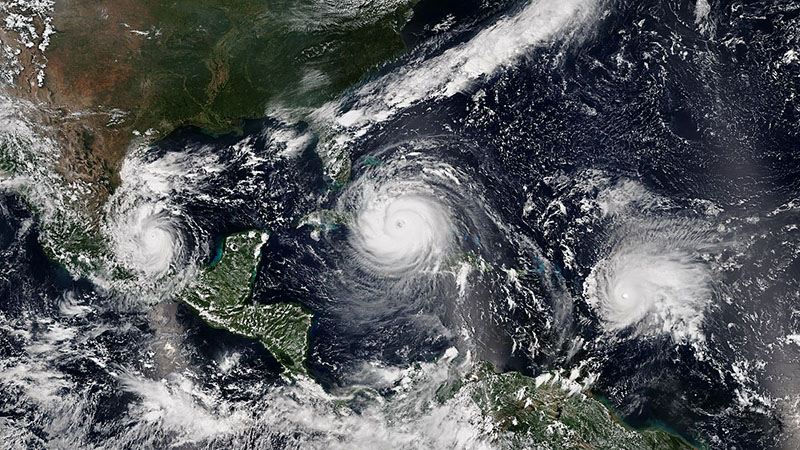Atmospher Sci & Global Chg
Research Highlights
August 2018
Hurricanes Gained Strength More Quickly in the Central and Eastern Atlantic Ocean Over the Last 30 Years
A positive shift in the Atlantic Multidecadal Oscillation and changes in the large-scale hurricane environment are behind the increase in magnitude of rapid intensification.

A study led by PNNL shows that hurricanes intensify more quickly now than they did 30 years ago. Hurricanes like Irma (center) and Jose (right) are examples of these types of hurricanes. Hurricane Katia is visible on the left. Credit: NOAA. Enlarge Image.
The Science
The magnitude of hurricane rapid intensification (RI)—when a hurricane increases in intensity by 25 knots or more in 24 hours—has increased in the central and eastern tropical Atlantic. Work by researchers from the U.S. Department of Energy's Pacific Northwest National Laboratory and the National Oceanic and Atmospheric Administration (NOAA) indicates that changes in RI are primarily driven by the current positive (warmer) phase of the Atlantic Multidecadal Oscillation (AMO).
The AMO is a natural cycle related to sea surface temperature, and is the prominent decadal climate phenomenon in the Atlantic. Increases in the upper-ocean heat content and a decrease in vertical wind shear fueled these increases in RI magnitude. In the western tropical Atlantic, where RI traditionally tends to occur, the changes were insignificant.
The Impact
Results from this study have substantial implications for the eastern Caribbean Islands, some of which were devastated during the 2017 Atlantic hurricane season. While some studies suggest a coming negative (cooling) swing of the AMO, others imply that the AMO may be amplified under global warming. The effect on hurricane RI shown in this study shows the need for better understanding of the AMO and its future.
Summary
RI of hurricanes is notoriously difficult to predict and can contribute to severe destruction and loss of life. While past studies examined the frequency of RI occurrence, changes in RI magnitude were not considered.
Here, researchers explored changes in RI magnitude using 30 years of satellite records, from 1986 to 2015. In the central and eastern tropical Atlantic, which includes much of the hurricane main development region, the 95th percentile (the number greater than or equal to 95 percent of the values) of 24-hour intensity changes increased at 3.8 knots per decade. In the western tropical Atlantic, encompassing the Caribbean Sea and the Gulf of Mexico, trends were insignificant.
This analysis revealed that warming of the upper ocean, coinciding with the positive phase of the AMO and associated changes in the large-scale environment, predominantly favored RI magnitude increases in the central and eastern tropical Atlantic.
For more information, read the PNNL news release, "Powerful hurricanes strengthen faster now than 30 years ago."
Acknowledgments
Sponsors: The U.S. Department of Energy Office of Science, Biological and Environmental Research supported K.B. and L.R.L. as part of the Regional and Global Climate Modeling program. G.F. was funded by base funds to the NOAA/Atlantic Oceanographic and Meteorological Laboratory's Physical Oceanography Division.
Research Area: Climate and Earth Systems Science
Research Team: Karthik Balaguru and L. Ruby Leung, PNNL; and Gregory R. Foltz, Atlantic Oceanographic and Meteorological Laboratory
Reference: K. Balaguru, G.R. Foltz, L.R. Leung, "Increasing Magnitude of Hurricane Rapid Intensification in the Central and Eastern Tropical Atlantic." Geophysical Research Letters 45(9), 4238-4247 (2018). [DOI: 10.1029/2018GL077597]